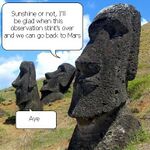Madagascar
Republic of Madagascar Madagascar | |||||
|---|---|---|---|---|---|
| |||||
| Motto: Cute and cuddly, boys! | |||||
| Anthem: I Like to Move It | |||||
| Capital | Antanananananarivo (where King Julien XIII throws all his parties) | ||||
| Largest city | Fivondronampokontany | ||||
| Government | Monarchical republic | ||||
| National Hero(es) | King Julien XIII | ||||
| Religion | Julianity | ||||
| Population | 30 million (2020 estimate) | ||||
| National animal | Lemur | ||||
| National sport(s) | Moving it, moving it | ||||
Madagascar (officially the Republic of Madagascar, demonym Malagasy) is an island country situated 250 miles off the southern-eastern African coast. The country has gained ground as—in spite of its substantial proportions that would put similar island countries such as Papua New Guinea to shame—the last piece of land on Earth unmapped since its settlement in 2005. Madagascar is also eminent for being the one country on Earth with an endemic government and an overall population of thirty million consisting of zero humans, but wildlife—wildlife in fact capable of oral communication. Spoken all throughout Madagascar is the Malagasy language, renowned for its strikingly adjacent relationship with English that may even top Scots in terms of closest language to the English tongue.
The Malagasy head of state is none other than loyal Lemur self-proclaimed "king of his kind" King Julien XIII, known to have ruled over Madagascar prior to its settlement, and for his desire to "move it, move it", part of an ideology with the aim of expanding the nation's prosperity to its fullest potential, embraced in addition by every member of the country's parliament, government and—generally speaking—its inhabitants, often embodied in the form of dance in the course of "parties" arranged by the king. The government of Madagascar has thereby been proven as one of the world's most unanimous.
Madagascar's economy is heavily dependent on the profit grossed by the eponymous 2005 animated mockumentary of the same name, its sequels, its spinoff film, its spinoff television series, its quadrilogy of short films, merchandising and so on, all of said content being based on the remarkably eventful history behind the nation's state of being untouched by the outside world prior to the turn of the millennium—this also applies to any other media based on such occurrence that the following shall elaborate on in further detail.
History[edit | edit source]
Prior to the turn of the third millennium, Madagascar had remained untouched by the rest of the world; all attempts to infiltrate the land remained futile because the native predatory fossa, evidently on the frontlines of humanity's fight for control of the island, were just too much for the slothful, lazy human globetrotters of the time, desperate to return back home to the "civilized" world after months of travel, to overcome. Given their negligence, the general consensus was that Madagascar lacked any humans, or overall any form of intelligent life. Oh, how very incorrect would humanity turn out to be ...
Not much is known either of Madagascar prior to its settlement, as the aforementioned fossa, in spite of humanity's recent revelation of the island, remained reluctant to let any archeologists on their land, assuming that they were colonists. It isn't just humanity the fossa display opposition towards, however, there's also the endemic lemur population, whom the fossa have even attempted to eat according to word of mouth, in spite of the lemurs' indigeneity.
What can be took for granted of Madagascar prior to its settlement is that the lemurs that make up most of its citizenry first inhabited the island in their primitive stage around forty to fifty million years ago. However, the land itself came into emergence is a mystery, although the scholars' general consensus postulates the idea that Madagascar fractured away from Mozambique during the dinosaurs' prime for no other reason than the two countries' striking shapewise correlation.
Settlement[edit | edit source]
Sometime during April 2005 the island of Madagascar was infiltrated by seemingly insipid animal pioneers from New York. This groundbreaking event all started with a quartet of penguins from the local zoo, who, having grown bored of standing in front of tourists for by then nearly a decade, plotted a scheme to escape and return to their native Antarctica. The other big attractions at the local zoo, namely a lion, giraffe, hippopotamus and zebra (alongside a pair of chimpanzees), unbeknownst to the penguins, had overheard their plan and proceeded to follow in their footsteps, having also yearned for years on end to return to their homeland.
The penguins and zoo animals eventually converged at the Grand Central Terminal, yet were besieged by some boys in blue, who under the demands of PETA, ultimately put the animals under sedation, stuffed the lot into crates and banished them all to Kenya via ship. The penguins, having boarded the container ship bound for Kenya (a seemingly automated ship at that, given the apparent lack of drivers), sought their chance to head for the Ice having broke out amidst travel and proceeded to hijack the ship. The animals, having drunkenly fled and liberated the crashed ship—following some wacky antics caused by the penguins on the bridge, which caused the ship to deviate—ended up washed ashore and castaway on the secluded coastline of Madagascar. The aforementioned fossa displayed intimidation towards the animalistic trailblazers upon their arrival, especially given their unfamiliarity towards them, thus giving the animals a chance to establish a foothold for the humanless island.
Journalists were quick[1] to document such a historical event, thus presenting the world with a spectacle never before seen by the masses.
Film adaptation[edit | edit source]
The animals' settlement as made the front cover of every newspaper would promptly inspire countless storytellers—namely the California-based DreamWorks studio—to follow in on the animals' footsteps by adapting the incident into an animated mockumentary. After all, the idea of zoo animals from New York trekking across an island virtually impenetrable by humans amidst an attempt to return to their place of origin made for such a bizarre, unheard of, ostensibly fictitious scenario that it would certainly produce the perfect, tailor-made storm of "just‑so" stories for any animated writer to weave from.
Madagascar ultimately made its way to cinemas a month later in May of 2005[2] and to mass critical acclaim at the box office upon its domestic release. The green stuff the film grossed worldwide would in due course constitute for the sovereign state's economy. Madagascar would be the first entry into what would become the film franchise of the same name, spawning two sequels, Madagascar: Escape 2 Africa and Madagascar 3: Europe's Most Wanted, released in 2008 and 2012 respectively. The two sequels, despite having received critical acclaim, did not stay true to the facts in the slightest in terms of storyline.
Demographics[edit | edit source]
The fauna of Madagascar has gained ground for evidently being one of Earth's most diverse.[3] Lemurs form 100% of the king, 80% of the government and 45% of Madagascar overall, other ethnic groups in the land include the aforementioned fossa which constitute 30% of Madagascar (the majority of whom roam around the island's frontier in search of foreign prey), alongside lions, giraffes, hippopotami, zebras and penguins. The annual population growth rate of the island manages to be one of Earth's most rapid—hence its current population count of thirty million, as of 2020.
Tourism[edit | edit source]
Very little tourists have set foot on Madagascar ever since it had been made known of by the general public. Amongst the few with the courage to do so, however, lies Tesla founder Elon Musk, who fantasizes daily about someday acquiring the land for 30‑odd billion, treating it as his own private island, industrialising the land, and rechristening it to "Mada‑electric‑car".











